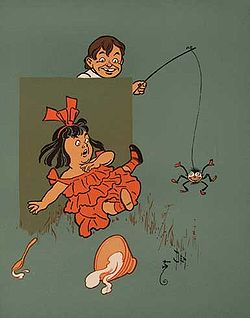
Arachnophobia
Encyclopedia

Arachne
In Greco-Roman mythology, Arachne was a great mortal weaver who boasted that her skill was greater than that of Minerva, the Latin parallel of Pallas Athena, goddess of wisdom and crafts. Arachne refused to acknowledge that her knowledge came, in part at least, from the goddess. The offended...
, "spider" and , phóbos
Phobia
A phobia is a type of anxiety disorder, usually defined as a persistent fear of an object or situation in which the sufferer commits to great lengths in avoiding, typically disproportional to the actual danger posed, often being recognized as irrational...
, "fear") is a specific phobia
Specific phobia
A specific phobia is a generic term for any kind of anxiety disorder that amounts to an unreasonable or irrational fear related to exposure to specific objects or situations...
, the fear of spiders and other arachnid
Arachnid
Arachnids are a class of joint-legged invertebrate animals in the subphylum Chelicerata. All arachnids have eight legs, although in some species the front pair may convert to a sensory function. The term is derived from the Greek words , meaning "spider".Almost all extant arachnids are terrestrial...
s such as scorpion
Scorpion
Scorpions are predatory arthropod animals of the order Scorpiones within the class Arachnida. They have eight legs and are easily recognized by the pair of grasping claws and the narrow, segmented tail, often carried in a characteristic forward curve over the back, ending with a venomous stinger...
s. It is a manifestation of zoophobia
Zoophobia
Zoophobia or animal phobia may have one of two closely related meanings: a generic term for the class of specific phobias to particular animals, or an irrational fear or even simply dislike of any non-human animals....
, among the most common of all phobia
Phobia
A phobia is a type of anxiety disorder, usually defined as a persistent fear of an object or situation in which the sufferer commits to great lengths in avoiding, typically disproportional to the actual danger posed, often being recognized as irrational...
s. The reactions of arachnophobics often seem irrational to others (and sometimes to the sufferers themselves). People with arachnophobia tend to feel uneasy in any area they believe could harbor spiders or that has visible signs of their presence, such as webs. If arachnophobics see a spider, they may not enter the general vicinity until they have overcome the panic attack that is often associated with their phobia. Some people scream, cry, have trouble breathing, excess sweating or even heart trouble when they come in contact with an area near spiders or their webs. One of the main concerns is that the person who suffers a panic avttack may have a heart attack or pass out due to the stress of the situation. In some extreme cases, even a picture or a realistic drawing of a spider can also trigger fear. Arachnophobics may also be touched by or touch an object and be afraid because it could feel like a spider. Arachnophobics may feel humiliated if such episodes occur in a social setting.
The fear of spiders can be treated by any of the general techniques suggested for specific phobias. As with all phobias, the strength of the associations means the individual must not actively pursue the consequences, and outsiders should not in any way undermine and "play" with the phobia in the meantime.
An evolutionary reason for the phobias, such as arachnophobia, claustrophobia
Claustrophobia
Claustrophobia is the fear of having no escape and being closed in small spaces or rooms...
, fear of snakes or mice
Fear of mice
Fear of mice and rats is one of the most common specific phobias. It is sometimes referred to as musophobia or murophobia , or as suriphobia, from the French souris, meaning mouse. Dr...
, etc. remains unresolved. One view, especially held in evolutionary psychology
Evolutionary psychology
Evolutionary psychology is an approach in the social and natural sciences that examines psychological traits such as memory, perception, and language from a modern evolutionary perspective. It seeks to identify which human psychological traits are evolved adaptations, that is, the functional...
, is that the presence of venomous spiders led to the evolution of a fear of spiders or made acquisition of a fear of spiders especially easy. Like all traits, there is variability in the intensity of fears of spiders, and those with more intense fears are classified as phobic. Spiders, for instance, being relatively small, don’t fit the usual criterion for a threat in the animal kingdom
Animal
Animals are a major group of multicellular, eukaryotic organisms of the kingdom Animalia or Metazoa. Their body plan eventually becomes fixed as they develop, although some undergo a process of metamorphosis later on in their life. Most animals are motile, meaning they can move spontaneously and...
where size is a factor, but nearly all species are venomous, and although rarely dangerous to humans, some species are dangerous. Arachnophobes will spare no effort to make sure that their whereabouts are spider-free, hence they would have had a reduced risk of being bitten in ancestral environments. Therefore, arachnophobes may possess a slight advantage over non-arachnophobes in terms of survival. However, this theory is undermined by the disproportional fear of spiders in comparison to other, potentially dangerous creatures that were present during Homo sapiens environment of evolutionary adaptiveness. Studies with crickets have shown that a fear of spiders can develop before birth.
The alternative view is that the dangers, such as from spiders, are overrated and not sufficient to influence evolution. Instead, inheriting phobias would have restrictive and debilitating effects upon survival, rather than being an aid. For some communities such as in Papua New Guinea
Papua New Guinea
Papua New Guinea , officially the Independent State of Papua New Guinea, is a country in Oceania, occupying the eastern half of the island of New Guinea and numerous offshore islands...
and South America
South America
South America is a continent situated in the Western Hemisphere, mostly in the Southern Hemisphere, with a relatively small portion in the Northern Hemisphere. The continent is also considered a subcontinent of the Americas. It is bordered on the west by the Pacific Ocean and on the north and east...
(except Chile
Chile
Chile ,officially the Republic of Chile , is a country in South America occupying a long, narrow coastal strip between the Andes mountains to the east and the Pacific Ocean to the west. It borders Peru to the north, Bolivia to the northeast, Argentina to the east, and the Drake Passage in the far...
, Colombia
Colombia
Colombia, officially the Republic of Colombia , is a unitary constitutional republic comprising thirty-two departments. The country is located in northwestern South America, bordered to the east by Venezuela and Brazil; to the south by Ecuador and Peru; to the north by the Caribbean Sea; to the...
, Brazil
Brazil
Brazil , officially the Federative Republic of Brazil , is the largest country in South America. It is the world's fifth largest country, both by geographical area and by population with over 192 million people...
, Uruguay
Uruguay
Uruguay ,officially the Oriental Republic of Uruguay,sometimes the Eastern Republic of Uruguay; ) is a country in the southeastern part of South America. It is home to some 3.5 million people, of whom 1.8 million live in the capital Montevideo and its metropolitan area...
, Argentina
Argentina
Argentina , officially the Argentine Republic , is the second largest country in South America by land area, after Brazil. It is constituted as a federation of 23 provinces and an autonomous city, Buenos Aires...
and Bolivia
Bolivia
Bolivia officially known as Plurinational State of Bolivia , is a landlocked country in central South America. It is the poorest country in South America...
), spiders are included in traditional foods. This suggests arachnophobia may be a cultural, rather than genetic trait.
In Western societies as many as 55% of females and 18% of males are estimated to experience arachnophobia.
Arachnophobia is the most common of all the phobias, and a way of treating the disorder would be cognitive-behavioral therapy, or medications. Some medications someone with this phobia might take would include anti-anxiety medications or anti-depressants. Also, a therapist might choose to have the subject partake in what is called "Exposure Therapy" where the person is exposed to virtual spiders and then eventually live spiders little by little until they have overcome the phobia.
External links
- Stiemerling D. Analysis of a spider and monster phobia, Z. Psychosom Med Psychoanal. October–December;1973 (4):327-45.
- National Geographic: Fear of Spiders rooted in Evolution

